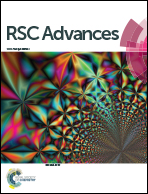Preparation of layered titanate with interlayer cadmium sulfide particles for visible-light-assisted dye degradation†
Abstract
Composite materials consisting of layered titanate and cadmium sulfide (CdS) particles were prepared via consecutive ion exchange and precipitation processes. Samples with different CdS loadings were characterized using X-ray diffraction, physical adsorption/desorption of nitrogen, scanning/transmission electron microscopy and ultraviolet-visible diffuse reflectance spectroscopy techniques. The photocatalytic properties of the samples in degrading methylene blue (MB) under visible light irradiation were evaluated. Results showed that CdS nanoparticles (NPs) were intercalated between titanate layers. The composite materials showed an improved photocatalytic activity as compared to both bulk CdS and a mixture of CdS and titanate. The intimate contact between titanate and CdS particles benefited interparticle electronic coupling. The observed improvement in photocatalytic activity is a combination of a number of contributions, including CdS photocatalysis, photosensitized degradation of MB over K2Ti4O9, and the synergistic effect between CdS and K2Ti4O9. The synergy indeed contributed to MB degradation and was found to depend on the content of CdS in the composite with an optimized content of 19 wt%, but it is not a dominant factor determining the overall photocatalytic activity of the composite.


 Please wait while we load your content...
Please wait while we load your content...